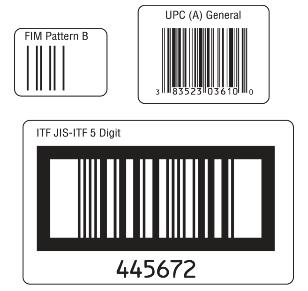About Selecting the Right Bar Code Font

The primary purpose of having bar code software is to render a specific printable image by using the proper point size. Any computer printer can print out bar code labels, but the desired effect is not always possible using just a word processor to create the bar code. Once a bar code is printed out on a series of labels, it should be readable with a bar code scanner.
Code 128 is ideal bar code font for companies that may use both ASCII characters and alpha-numeric characters on bar code labels. Since Code 128 supports all ASCII characters, making bar code labels for shipping or merchandise purposes is easy. There are six aspect ratios for Code 128 bar code fonts.
The Code 39 bar code font is commonly seen on library book bar code labels, but is also used for any bar code that does not require a checksum. Also used by the healthcare industry, Code 39 bar codes can be made small enough for use on specimen and test tubes for tracking purposes.
UPC bar codes can be found practically everywhere in stores in the United States, and is the standard bar code font for retail products. Unlike other types of bar codes, a UPC bar code must be unique in order to distinguish one product on the market from another. No two different products will ever have the same UPC bar code. But once you have been assigned or purchased a UPC number, these bar codes can be easily printed using bar code software - although, when preparing a UPC label to be replicated on packaging, it is important to test the image with a bar code verfier.
EAN (European Article Numbering) 8/13 bar code fonts are used in Europe much the same way the UPC bar codes are used in the United States.
The 2/5 Interleaved bar code font consists of a high density numeric bar code which means that only pairs of numbers can be encoded. This is a basic bar code for anyone who wants to use a numbers-only bar code for identification purposes. 2/5 Interleaved bar code fonts look similar to the Code 128 bar codes and are used in shipping.
If you are not required to adhere to a specific standard, then you are going to have more flexibility in choosing the right barcode to represent the data you want to encode. Do you want to encode:
-
Numbers and letters, or just numbers?
-
Uppercase letters, lowercase letters, or both?
-
Special characters including @ # $ % ^ & * ) and others?
-
Special functions such as tab, carriage return, etc.?
-
Approximately how many total characters do you need to encode in your barcodes? (i.e. less than 13, less than 50 or more than 50?)
The above questions are very important because they will determine which barcode is going to meet your needs. In fact, there are really only a few barcodes that should be considered if you are not being held to an industry-required standard:
-
Code 39 can generally encode up to about 13 total characters consisting of uppercase letters and numbers. IDAutomation products that generate Code 39 can also encode the space character.
-
Code 128 is used for encoding up to approximately 50-60 total characters consisting of uppercase and/or lowercase letters, numbers, special symbols and some functions. Special symbols and functions usually consist of more than one character to encode however, and it is good to stay aware of that when determining your overall number of encoded characters.
-
QR, Data Matrix and PDF417 2D Barcodes typically encode upwards of 800 characters in a single symbol, consisting of any combination of numbers, upper and lowercase letters, special characters and functions. These are the best option when encoding large amounts of data.
Of course, there are other things to consider when deciding on which barcode to use in a given project or process. If your barcodes are in danger of being damaged, for example, consider a 2D barcode for its’ high level of error correction which means the barcode can take a certain amount of damage and still receive an accurate scan. Density is also something to consider, with 2D barcodes taking up less space than Code 128 barcodes which are more compact than Code 39 barcodes. Finally, complexity of encoding may play a role in your decision. Code 39 only requires an asterisk at the beginning and end of your data while other linear barcodes and 2D barcodes require far more complicated encoding processes.
Nate Schubert of ID Automation contributed to this content. Nate is the ECommerce & Marketing Manager at IDAutomation, a leading provider of barcode generation software solutions that help businesses reach more efficient and profitable levels of production by minimizing human error through the automation process. IDAutomation provides both bar code software and hardware to companies since 1996 and is located in Tampa, Florida.
http://www.idautomation.com/fonts/
Click for other bar code resources
(You can help us keep this site free and productive by letting vendors know you've seen them on Barcode.com - thank you!)
